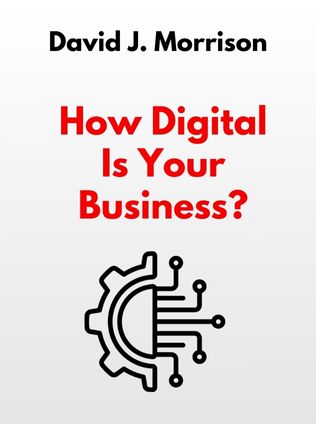
How Digital Is Your Business?
By David J. Morrison,
Published 11/2000
How Digital is Your Business? Using Digital Technology to Become Unique
By Adrian J. Slywotzky and David J. Morrison with Karl Weber
About the Author
Adrian J. Slywotzky is the author of Value Migration and the co-author of The Profit Zone and Profit Patterns. He is a vice president of Mercer Management Consulting and was named one of the six most influential people in management by Industry Week. David J. Morrison, co-author of The Profit Zone and Profit Patterns, is vice chairman of Mercer Management Consulting and head of MercerDigital, the firm's e-commerce practice. Karl Weber is a writer and editor specializing in business and current affairs.
Main Idea
"How Digital is Your Business?" explores the critical importance of digital transformation for companies today. It emphasizes that digital business design (DBD) involves using digital technologies to create unique and superior business models. The book outlines how businesses can effectively leverage digital technologies to enhance value propositions for customers and employees, improve profitability, and protect their competitive edge.
Table of Contents
- Getting Started in Digital Business Design
- The Choiceboard: A DBD Tool
- 10X Productivity
- Hybrid Power: The Incumbent's Advantage
- The Active Customer
- Obstacles to Going Digital: Beating the Odds
- Dot-Coms on the Move
- The Digital Organization
Getting Started in Digital Business Design
Creating a digital business design (DBD) begins with asking and answering five key questions about the most important business issues facing your organization, the smartest business design choices, and the differentiation between managing atoms and bits. The strategic focus involves identifying crucial factors for success and choosing smart business designs to address them.
- Cemex: This cement company leverages a real-time information system to deliver cement efficiently, outperforming competitors in productivity and profitability.
- Atoms vs. Bits: Managing atoms involves physical assets, while managing bits focuses on information, which is cheaper and more efficient.
"Going digital means creating unique value propositions for customers and employees while ensuring robust profitability and strategic control." - Adrian J. Slywotzky
The book highlights Cemex, a giant Mexican cement company, as a prime example of a traditional business successfully transitioning to a digital model. Cemex developed a real-time information system linked worldwide, allowing it to deliver cement where and when it is needed with minimal delay and waste. This system has made Cemex the world's third-largest cement manufacturer, outstripping its major rivals in productivity and profitability.
Cemex's approach exemplifies the concept of managing bits instead of atoms. By focusing on information management rather than physical asset management, Cemex has significantly improved its operational efficiency and customer satisfaction. The company's trucks are linked via GPS, ensuring timely delivery and reducing the risk of cement hardening in transit. This real-time information system also enables Cemex to add local cement companies to its worldwide network seamlessly.
As businesses transition to digital models, understanding the difference between managing atoms and bits becomes crucial. Managing atoms involves dealing with physical assets like inventory, equipment, and factories, which is often costly and slow. In contrast, managing bits focuses on handling information, which is cheaper, faster, and more efficient. Digital Business Design aims to develop bit engines that manage information digitally, enhancing the overall business model and providing maximum benefit.
The Choiceboard: A DBD Tool
The Choiceboard is an interactive online system that allows customers to design their own products and services by choosing from a menu of attributes, components, prices, and delivery options. This customization leads to higher customer satisfaction and operational efficiency.
- Mattel's My Design Barbie allows customers to select hairstyle, color, complexion, and eye color.
- De Beer's Design Your Own Engagement Ring offers 189 unique combinations of cuts, bands, and side-stones.
- Cisco's Marketplace provides an online configurator for network gear.
- Charles Schwab's Mutual Fund Finder lets investors design their own portfolios.
"The Choiceboard transforms the buying experience from guessing what customers want to knowing exactly what they want." - David J. Morrison
Before implementing a Choiceboard, companies must ensure that both their customers and their supply systems are digitally ready. Customers should have access to personal computers and be comfortable using them for transactions. The company must also have reliable suppliers who can deliver components as needed to support the customized orders generated by the Choiceboard.
Choiceboards represent a significant shift from traditional product offerings, where companies guess what customers want and produce fixed product lines. With Choiceboards, customers can tailor products to their exact preferences, leading to higher satisfaction and loyalty. This approach also benefits companies by reducing waste and increasing efficiency, as they only produce what has been pre-ordered and paid for.
Sign up for FREE and get access to 1,400+ books summaries.
You May Also Like
Rich Dad Poor Dad
What the Rich Teach Their Kids About Money - That the Poor and Middle Class Do Not!
By Robert T. KiyosakiFreakonomics
A Rogue Economist Explores the Hidden Side of Everything
By Steven D. Levitt and Stephen J. DubnerThe Lean Startup
How Today's Entrepreneurs Use Continuous Innovation to Create Radically Successful Businesses
By Eric RiesWho Moved My Cheese?
An Amazing Way to Deal with Change in Your Work and in Your Life
By Spencer Johnson, M.D.Factfulness
Ten Reasons We're Wrong About the World – and Why Things Are Better Than You Think
By Hans RoslingMake Your Bed
Little Things That Can Change Your Life...And Maybe the World
By William H. McRaven



















